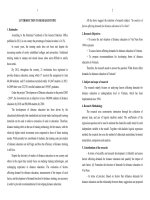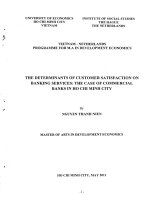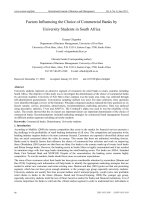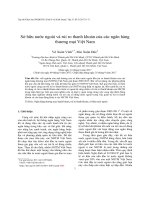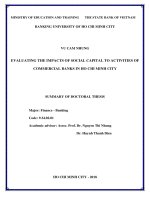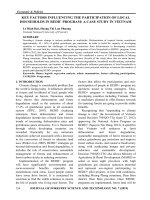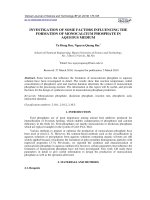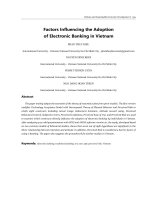Factors influencing the liquidity of commercial banks in vietnam
Bạn đang xem bản rút gọn của tài liệu. Xem và tải ngay bản đầy đủ của tài liệu tại đây (1.81 MB, 85 trang )
THE STATE BANK OF VIETNAM
MINISTRY OF EDUCATION AND TRAINING
HO CHI MINH
UNIVERSITY OF
BANKING
HOANG DANG KHAI
FACTORS INFLUENCING THE LIQUIDITY OF
COMMERCIAL BANKS IN VIETNAM
GRADUATION THESIS
MAJOR: BANKING AND FINANCE
CODE: 7340201
SUPERVISOR: DR. NGUYEN DUY LINH
HO CHI MINH CITY – 2022
THE STATE BANK OF VIETNAM
MINISTRY OF EDUCATION AND TRAINING
HO CHI MINH
UNIVERSITY OF
BANKING
HOANG DANG KHAI
STUDENT CODE: 050606180154
HQ6-GE04
FACTORS INFLUENCING THE LIQUIDITY OF
COMMERCIAL BANKS IN VIETNAM
GRADUATION THESIS
MAJOR: BANKING AND FINANCE
CODE: 7340201
SUPERVISOR: DR. NGUYEN DUY LINH
HO CHI MINH CITY – 2022
ABSTRACT
The topic " FACTORS INFLUENCING THE LIQUIDITY OF COMMERCIAL
BANKS IN VIETNAM" is based on previous researches related to factors affecting the
liquidity of Vietnamese commercial banks; The scope of the study is 25 Vietnamese
commercial banks in the period 2012-2021. Besides, research data is secondary data
collected from audited consolidated financial statements of commercial banks, General
Statistics Office and World Bank.
The topic uses a univariate regression model with the dependent variable being
bank liquidity and the independent variables being Bank size (SIZE), Equity ratio
(CAP), Loan-to-deposit ratio (LDR), Return on equity (ROE), Non-performing loan
(NPL), Economic growth (GDP), Inflation rate (INF). Through the regression models
Pooled-OLS, FEM, REM, FGLS, along with some tests to find a complete model and
have statistical significance. The model estimation results show that the variables LDR,
NPL, and GDP have a negative impact on the liquidity of the bank; in contrast, the
variables SIZE, CAP, ROE, and INF have a positive impact on the liquidity of banks.
However, only variables such as LDR, ROE, and INF are statistically significant.
Based on the research results, the study contributes to providing suggestions and
policy implications for bank administrators to both manage the liquidity of Vietnamese
banks and meet both profitability.
TABLE OF CONTENTS
ABSTRACT ......................................................................................................................
TABLE OF CONTENTS ..................................................................................................
DECLARATION OF AUTHENTICITY ..........................................................................
ACKNOWLEDGEMENT .................................................................................................
LIST OF ABBREVIATIONS ...........................................................................................
LIST OF TABLES ............................................................................................................
LIST OF GRAPHS ............................................................................................................
CHAPTER 1: INTRODUCTION.................................................................................... 1
1.1 INTRODUCTION .................................................................................................... 1
1.2 THE NOVELTY OF THE TOPIC ................................................................................ 3
1.3 THE AIM OF THE THESIS ....................................................................................... 3
1.3.1 Overall objectives ........................................................................................ 3
1.3.2 Particular objectives .................................................................................... 3
1.4 THE RESEARCH QUESTIONS .................................................................................. 4
1.5 SUBJECT AND SCOPE OF THE RESEARCH............................................................... 4
1.6 METHODOLOGY ................................................................................................... 4
1.7 RESEARCH CONTENT ............................................................................................ 5
1.8 CONTRIBUTION OF THE THESIS............................................................................. 5
1.9 THE PROPOSED LAYOUT OF THE THESIS ............................................................... 5
SUMMARY OF CHAPTER 1 ........................................................................................ 7
CHAPTER 2: THEORETICAL FRAMEWORK .......................................................... 8
2.1 LIQUIDITY OF COMMERCIAL BANKS ..................................................................... 8
2.1.1 Liquidity concept ......................................................................................... 8
2.1.2 Bank liquidity .............................................................................................. 8
2.1.3 Supply and demand of liquidity and net liquidity position ......................... 9
2.2 LIQUIDITY MEASUREMENT METHOD .................................................................. 11
2.2.1 Liquidity gap measurement method .......................................................... 11
2.2.2 Liquidity ratio measurement method ........................................................ 12
2.3 FACTORS INFLUENCING BANK LIQUIDITY .......................................................... 13
2.3.1 Group of factors inside the bank ............................................................... 13
2.3.2 Group of factors outside the bank ............................................................. 15
2.4 EMPIRICAL RESEARCH OVERVIEW ..................................................................... 16
2.4.1 Foreign research ........................................................................................ 16
2.4.2 Domestic research ..................................................................................... 18
2.4.3 The research gaps ...................................................................................... 19
SUMMARY OF CHAPTER 2 ...................................................................................... 20
CHAPTER 3: RESEARCH MODEL ............................................................................ 21
3.1 ANALYSIS PROCESS ............................................................................................ 21
3.2 SAMPLES AND RESEARCH DATA ......................................................................... 23
3.2.1 Research samples....................................................................................... 23
3.2.2 Research data ............................................................................................. 23
3.2.3 Research tools ............................................................................................ 23
3.3 METHODOLOGY ................................................................................................. 24
3.3.1 Qualitative method .................................................................................... 24
3.3.2 Quantitative method .................................................................................. 24
3.4 RESEARCH MODEL AND HYPOTHESIS ................................................................. 25
3.4.1 Research model ......................................................................................... 25
3.4.2 Description of variables and hypotheses ................................................... 26
SUMMARY OF CHAPTER 3 ...................................................................................... 30
CHAPTER 4: RESEARCH RESULTS......................................................................... 31
4.1 DESCRIPTIVE STATISTICS ................................................................................... 31
4.2 RESEARCH RESULTS ........................................................................................... 33
4.2.1 Correlation analysis ................................................................................... 33
4.2.2 Multicollinearity test ................................................................................. 35
4.3 REGRESSION RESULTS OF THE RESEARCH MODEL .............................................. 36
4.3.1 Comparison of regression results between two models, Pooled OLS and
FEM 37
4.3.2 Comparison of regression results between two models, FEM and REM.. 37
4.3.3 Defect tests ................................................................................................ 38
4.3.4 Final model ................................................................................................ 39
4.4 SUMMARY .......................................................................................................... 40
4.4.1 Bank size (SIZE) ....................................................................................... 40
4.4.2 Equity ratio (CAP) ..................................................................................... 41
4.4.3 Loan-to-deposit ratio (LDR) ..................................................................... 41
4.4.4
4.4.5
4.4.6
4.4.7
Return on equity (ROE)............................................................................. 42
Non-performing loan ratio (NPL) ............................................................. 42
Economic growth rate (GDP) .................................................................... 42
Inflation rate (INF) .................................................................................... 43
SUMMARY OF CHAPTER 4 ...................................................................................... 44
CHAPTER 5: CONCLUSION AND POLICY IMPLICATIONS ............................... 45
5.1 CONCLUSION ...................................................................................................... 45
5.2 POLICY IMPLICATIONS ....................................................................................... 46
5.2.1 For commercial banks ............................................................................... 46
5.2.2 For the State Bank of Vietnam .................................................................. 47
5.3 LIMITATIONS OF THE THESIS .............................................................................. 48
5.4 PROPOSING DIRECTIONS FOR FURTHER RESEARCH ............................................ 49
SUMMARY OF CHAPTER 5 ...................................................................................... 50
REFERENCES .............................................................................................................. 51
APPENDIX ................................................................................................................... 53
APPENDIX A. LIST OF COMMERCIAL BANKS IN VIETNAM IN THE RESEARCH SAMPLE.
................................................................................................................................... 53
APPENDIX B CALCULATED DATASET ......................................................................... 55
APPENDIX C REGRESSION RESULTS WITH STATA 16.0 .............................................. 69
DECLARATION OF AUTHENTICITY
I declare that this is my independent thesis. The data used in the thesis are of clear
origin and published following the law. The research results in the thesis are my
research and analysis, honestly, objectively, and by following the reality of Vietnam.
These results have not been published in any previous papers.
Ho Chi Minh City, November 2022
The Author
Hoang Dang Khai
ACKNOWLEDGEMENT
Firstly, I would like to send my profound gratitude to all the lecturers at Banking
university, in the Office of Academic Affairs, and especially to the Department of
Finance and the Department of Banking lecturer while studying for a bachelor’s degree
at the Ho Chi Minh University of Banking
Secondly, I would like to express my sincerest and most profound thankfulness to
Dr. Nguyen Duy Linh for his guidance and patience in giving me valuable
recommendations during my study period. I am happy and fortunate to carry out this
study under his supervisor.
Lastly, I would like to thank my family for their support during my study and life.
Without encouragement and sacrifice, I would not have finished this thesis, so I
express my special love and gratitude to them.
In the implementation process, mistakes are inevitable despite consulting,
exchanging, and absorbing suggestions from teachers and friends. With the effort to
improve more and more, I look forward to receiving valuable advice from teachers and
friends.
I sincerely thank!
LIST OF ABBREVIATIONS
CPI
Consumer Price Index
FEM
Fixed Effects Model
FGLS
Feasible Generalized Least Squares
GSO
General Statistics Office
JSCBs
Joint Stock Commercial Banks
NLP
Net Liquidity Position
POLS
Pooled Ordinary Least Square
REM
Random Effects Model
SBV
State Bank Of Vietnam
VIF
Variance Inflation Factor
LIST OF TABLES
Table 2.1: Banking activities forming the supply and demand for liquidity................. 10
Table 3.1: Description of variables in the research model ............................................ 26
Table 4.1: Variable Statistics ......................................................................................... 31
Table 4.2: Correlation matrix ........................................................................................ 33
Table 4.3: Multicollinearity test .................................................................................... 35
Table 4.4: Regression results of models ........................................................................ 36
Table 4.5: F-test test ...................................................................................................... 37
Table 4.6: Hausman test ................................................................................................ 37
Table 4.7: Modified Wald test ....................................................................................... 38
Table 4.8: Wooldridge test ............................................................................................ 38
Table 4.9: Regression result of FGLS ........................................................................... 39
Table 4.10: Summary of expected hypothesis and experimental results ...................... 40
LIST OF GRAPHS
Graph 3.1: Research process ......................................................................................... 21
CHAPTER 1: INTRODUCTION
1.1
Introduction
In theory, the liquidity of commercial banks is considered as the ability to meet
the immediate needs of commercial banks for money, such as withdrawing deposits
and disbursing committed credits, paying the costs of operations, or other needs to be
paid by cash.
Liquidity is a crucial factor determining the safety of commercial banks. A bank
default due to the lack of liquidity will cause a domino effect on other commercial
banks. A typical example of this is the global financial crisis in 2008 due to the
weakness of the financial system, specifically the lack of liquidity at commercial
banks. During the global financial crisis, many banks had to find ways to maintain
liquidity. Despite the financial help of the central bank, many banks still had to declare
bankruptcy, and some were forced to merge with other banks. Many commercial
banks, although profitable, can still face difficulties in asset and capital management,
which has led to a liquidity crisis. After the banking system crisis in 2008, Basel III
was officially introduced in 2013, with regulations relating to liquidity factors in order
to minimize the economic damage caused by banks may cause.
In Vietnam, the state bank also imposed some regulations to ensure more
liquidity for commercial banks. According to Circular No. 22/2019/TT-NHNN, dated
November 15, 2019, of the State Bank of Vietnam stipulating the limits and ratios to
ensure safety in operations of banks and foreign bank branches, from on January 1,
2020 (the effective date of the circular), the maximum loan-to-deposit ratio (LDR) is at
85%. The maximum rate of short-term capital used for medium and long-term loans of
banks and foreign bank branches currently applied by the State Bank is 34% from
October 1, 2021, to the end of May 30, September 2022, then reduced to 30% from
October 1, 2022, according to the latest revised Circular 22/2019/TT-NHNN.
1
In the face of the constantly changing and volatile situation of Vietnam's financial
sector in general and the banking industry in particular, the study was conducted to
determine the factors affecting the liquidity of Vietnam's commercial banking system
in the current context.
Banks are one of the vital components of each country's economy; they play a
crucial role in regulating the macroeconomy through credit financing, facilitating the
process of integration of economic and production activities. Along with its essential
role, banking governance is also an extremely important issue for governments in
monitoring and management, in which liquidity is the top priority in banking
governance.
Liquidity has long played an essential role in deciding the existence and
development of each commercial bank in particular and the commercial banking
system in general. In recent times, the world economy and global financial markets
have been continuously negatively affected by the Russia-Ukraine conflict, which has
pushed up the prices of oil, gold, and other essential commodities due to sanctions,
embargos from the West, and retaliatory measures from Russia. Inflation has been
running high for over a decade, prompting major central banks to race to raise interest
rates to cool it down. In Vietnam, after the pandemic passed and the economy
reopened, commercial banks disbursed at full capacity to boost production and
accelerate economic recovery. Therefore, the depletion of the credit room occurred
from the beginning of 2022 and caused commercial banks to apply and request the
State Bank to lose the credit room to be able to disburse credit. Continuous hot credit
growth will create many difficulties and obstacles in meeting liquidity needs in the
future as well as in banking governance in a volatile world economy like today.
Liquidity issues of commercial banks in Vietnam are always a hot topic of
interest at the beginning of each year. The goal of liquidity is to ensure the bank's
continuous and stable operation. If banks have good liquidity, it will help stabilize the
financial market as well as promote the smooth operation of the economy. Therefore,
2
the author has chosen to study the topic "Factors affecting liquidity at commercial
banks in Vietnam" for the graduation thesis.
1.2
The novelty of the topic
The topic was written in the post-covid context when the SBV was stimulating
the economy to recover after years of a stagnant pandemic. Through monetary policies
and interest rate support packages to encourage industries affected by covid-19,
commercial banks quickly disbursed at full capacity, reaching the limit of credit room
that the State Bank had applied at the beginning of 2022. Since the outbreak of the
pandemic, the economy has been shut down, but banks have made even better profits
than in previous years while keeping liquidity at a good level. Therefore, this topic
focuses on analyzing how the factors affecting the bank's liquidity have changed before
and during the covid pandemic while still maintaining outstanding profitability. From
there, creating a premise for bank administrators to apply the recommendations and
suggestions given by the author to help banks increasingly improve their safety under
the Basel framework along with the ability to profitability, creating prestige and
position for Vietnamese commercial banks.
1.3
The aim of the thesis
1.3.1 Overall objectives
The overall objective of the study is to identify the factors affecting the liquidity
of commercial banks in Vietnam, thereby providing solutions and recommendations to
effectively manage the bank's liquidity.
1.3.2 Particular objectives
Determining the factors impacting the liquidity of commercial banks in
Vietnam.
Measuring and assessing the impact direction of each factor influencing the
liquidity of commercial banks in Vietnam.
3
Proposing recommendations to manage the liquidity of Vietnamese commercial
banks to ensure both liquidity and profitability.
1.4
The research questions
Based on the particular objectives mentioned above, the thesis will, in turn,
answer the following questions:
What factors affect the liquidity of commercial banks in Vietnam?
What is the impact level and direction of these factors on the liquidity of
Vietnam's commercial banks?
What are suggestions that can manage the liquidity of Vietnamese commercial
banks to meet both liquidity and profitability?
1.5
Subject and scope of the research
Research subject: Factors influencing the liquidity of commercial banks.
Research scope: samples were collected from financial statements of 25
Vietnamese commercial banks listed on the Stock Exchange in the period 2012 2021. The criteria needed for the study are shown in the financial statements of
the banks.
1.6
Methodology
Qualitative method: analyze and evaluate the situation of domestic and foreign
research related to the research thesis and synthesize the necessary theoretical
bases, test the research's hypothesis
Quantitative method: perform based on data collected from annual financial
statements of banks. The thesis uses commonly used estimation models for
panel data: fixed effects regression model (FEM), random effects regression
model (REM), and compound least squares model (POLS). In addition, there are
tests and remedies for defects to establish the optimal regression model.
4
1.7
Research content
The study analyzes and evaluates factors influencing the liquidity of Vietnamese
commercial banks in the period 2012 - 2021. From that, it examines the impact level of
these factors on the liquidity of Vietnamese commercial banks through the use of
econometric models to test the effect and significance level of this effect. The
assessment and explanation of the factors influencing the liquidity of Vietnamese
commercial banks based on the actual operation of the banking industry in the research
period will be carried out, and finally, propose solutions for improving the efficiency
and safety of Vietnamese commercial banks.
1.8
Contribution of the thesis
Theoretically, the thesis contributes to building an empirical research model in
Vietnam to understand the financial and macro factors affecting the liquidity of
commercial banks. From the research results, the study will open up many new and
more in-depth research directions.
Determining the factors affecting liquidity at Vietnamese commercial banks will
show the relationship between these factors as well as the degree of negative or
positive influence on the liquidity of Vietnamese commercial banks. Thereby
proposing solutions and appropriate management policies to maintain good liquidity at
Vietnamese commercial banks.
1.9
The proposed layout of the thesis
- Chapter 1: Introduction
This chapter introduces an overview of the urgency of the thesis, the purpose, and
scope of the research, presents domestic and international studies, as well as a quick
view outline of the research methods used.
- Chapter 2: Theoretical framework
Presents basic concepts and underlying theories.
5
- Chapter 3: Research model
Focus on presenting the research method used in the thesis, including the research
process, research hypothesis, conditions, and sampling procedure, how to collect input
data sources, and how to determine the value of the data, variables, and test methods
used for the study.
- Chapter 4: Data analysis, Findings, and Discussion
Mainly focus on discussing experimental research results in chapter 3.
- Chapter 5: Conclusions and Recommendations
Briefly present the results obtained from the study. From that, gives conclusions
and recommendations.
6
SUMMARY OF CHAPTER 1
Chapter 1 points out the importance and urgency of analyzing the factors
affecting the liquidity of Vietnamese commercial banks. The thesis gives 3 particular
research objectives from the general research objective and will be solved through 3
corresponding research questions. Next, the topic presents the research's object and
scope, which are 25 Vietnamese commercial banks from 2012 to 2021. The thesis uses
qualitative research methods and quantitative research methods based on inheritance
and expands previous studies to update factors affecting liquidity that can change over
time. Finally, this chapter will present the structure of the thesis consisting of 5
chapters and a summary of the main content of each chapter.
7
CHAPTER 2: THEORETICAL FRAMEWORK
2.1
Liquidity of commercial banks
2.1.1 Liquidity concept
From the perspective of assets, liquidity is the ability of assets to be converted
into cash and vice versa. An asset is considered liquid when it meets the following
criteria: Availability of quantity to buy or sell, availability of market to trade,
availability of time to trade, and reasonable price.
According to the Basel Committee on Banking Supervision, liquidity is a
technical term that refers to the ability to meet the needs of using available capital, and
serving business activities at all times, such as deposit payment, lending, payment, and
capital transactions.
At different times, Basel had different concepts of liquidity, but in general,
liquidity was defined as the ability to increase asset funds and meet due obligations at
an acceptable cost.
In fact, assets with high liquidity include valuable papers such as Treasury bills,
certificates of deposit, promissory notes, bills of exchange, etc., and low-liquid assets
such as real estate, machinery, equipment, or production lines.
2.1.2 Bank liquidity
From a banking perspective, liquidity is the ability to fully and promptly meet
financial obligations arising in the process of operations and transactions such as
deposit payment, lending, payment, and other activities of financial transactions.
According to Basel (2008), the definition of bank liquidity is as follows: "Bank
liquidity is the ability of a bank to both increase its assets and meet its debt obligations
when they come due without incurring excessive losses." When a bank is unable to
fulfill its obligations, such as disbursing loans, paying deposits at maturity, or making
8
payments and financial transactions entirely and on time, it means that the bank is
insolvent in liquidity” (Bessis, 2012).
With the definitions gathered above, the author can summarize the concept of
bank liquidity, which is represented by the bank fully and timely meeting its committed
obligations, such as paying deposits at maturity, disbursing loans, making payments
and financial transactions at a reasonable and low cost to avoid causing significant
losses leading to insolvency of the bank.
2.1.3 Supply and demand of liquidity and net liquidity position
2.1.3.1 Supply and demand of liquidity
Liquidity supply represents the bank's ability to supply cash to meet the payment
needs of customers on time. When a bank has an abundant liquidity supply, it will
increase the bank's liquidity. Liquidity supply is formed from many different sources,
from available cash or can be mobilized in a short time.
Liquidity demand reflects the disbursement and payment needs of customers that
the bank is obliged to meet immediately or in a short period of time. In other words,
liquidity demand is the amount that will reduce the bank's cash budget.
9
Table 2.1: Banking activities forming the supply and demand for liquidity
LIQUIDITY SUPPLY
LIQUIDITY DEMAND
Accepting deposits
Customers withdraw deposits
Loans are repaid
Payment of due loans
Proceeds from providing products and
Payment of operating expenses
services
Money market loans
Cash dividend payment
Proceeds from property sales
Disbursing new loans or investment
Paying costs incurred in the process of
Issuance of new shares
providing products and services
Source: Rose (2004)
2.1.3.2 Net liquidity position
The combination of a bank's liquidity supply and demand will make up its Net
Liquidity Position (NLP) which is calculated according to Nguyễn Văn Tiến (2015) as
follows:
If NLP > 0 or liquidity supply is more significant than liquidity demand, in this
state, the bank is in a surplus of liquidity. It can be seen that the bank's current liquidity
is positive, but on the other hand, it shows that the bank's profitability has not been
fully exploited. Possible causes of a liquidity surplus include banks actively increasing
liquidity reserves, unreasonable investment or a stagnant economy that does not have
many investment opportunities, capital growing too fast, etc.
If NLP < 0, or liquidity supply is smaller than liquidity demand, in this state, the
bank is in a liquidity deficit. Liquidity deficit is one of the risk factors for commercial
banks' operations. A slight deficit makes it difficult for banks to operate. In contrast, a
10
large deficiency leads to more severe problems such as losing customers, losing
business opportunities, losing markets, reducing public confidence, etc. (Trương
Quang Thông, 2010). The necessary actions to offset liquidity can be listed as selling
illiquid assets, using required reserves, borrowing interbank, borrowing from Lenders
of last resort, etc.
If NLP = 0, or liquidity supply equals liquidity demand, the bank is in liquidity
equilibrium. This is the goal of the bank administrators, but in practice, the liquidity
equilibrium is difficult to achieve.
2.2
Liquidity measurement method
Vodova (2011) offered two methods to measure liquidity: measurement by
liquidity gap and measurement by liquidity ratios.
The liquidity gap measurement method is a method of measuring the difference
between capital and assets at present and in the future.
Liquidity ratios are a method of calculating various ratios collected from balance
sheet data, thereby predicting liquidity movements.
2.2.1 Liquidity gap measurement method
The liquidity gap is the difference between the average total loan balance and the
average total mobilized capital. The liquidity gap represents a warning sign of the
bank's future liquidity risk.
Suppose the liquidity gap is positive and has an enormous value. In that case, the
bank is forced to reduce cash reserves, reduce liquid assets, or borrow additional
money in the money market, leading to an increase in the bank's liquidity risk. (Đặng
Văn Dân, 2015). The method of measuring liquidity by calculating the liquidity gap is
the most appropriate method in quantitative analysis, and the liquidity gap index
reflects the most basic of the bank's liquidity.
11
2.2.2 Liquidity ratio measurement method
There are many ways to measure a bank's liquidity. Rose (2004) measured the
liquidity of a bank using the liquidity index method. This method has been applied by
many typical researchers, such as Vodova (2011), Bunda & Desquilbet (2008). This
method includes four liquidity indicators as follows:
Liquid assets in L1 include cash, trading securities, and deposits with central
banks or other credit organizations. This ratio shows how much of a commercial bank's
total assets are liquid assets. Usually, a high index indicates an excellent liquidity
position and low liquidity risk, but it also shows that the bank is operating inefficiently
due to holding too many assets with low profitability or unprofitable assets.
Liquidity ratio L2 shows how liquid assets are compared to deposits and
mobilized capital. This ratio is the same as L1; the higher the L2 ratio (greater than or
equal to 100%), the better the bank's liquidity.
This ratio shows how much of a bank's total assets are outstanding loans. The
higher this ratio, the lower the bank's liquidity, which leads to a higher risk of the
bank's liquidity risk.
This ratio is similar to the L3 index. The higher the ratio, the lower the bank's
liquidity.
12
L1 and L2 indexes measure absolute liquidity, while L3 and L4 indexes measure
relative liquidity.
Most authors have used all four liquidity ratios to assess the liquidity of banks,
such as Vodova (2011), Aspachs et al. (2005), Vũ Thị Hồng (2015). However, the
author only chooses the L1 index to assess the liquidity of the bank because this index
gives us the most general view of the bank's liquidity in both the short and mediumlong term. The L1 index shows how much of a bank's total assets are liquid assets that
the bank can reserve to hedge against liquidity risk. In the short term, if a bank in
Vietnam is facing a sudden liquidity shortage, it can still borrow money on the
interbank market or with support from the Lender of Last resort to compensate
liquidity shortage without leading to bankruptcy. However, the cost to make up for this
lack of liquidity is not cheap; if the situation lasts for a while, it will significantly affect
the bank's profit and operational efficiency, forcing it to be on the verge of bankruptcy
or the State Bank will repurchase it at 0 dongs in Vietnam. Therefore, the L1 index will
be superior to other indexes when assessing liquidity in both the short-term and long
term.
2.3
Factors influencing bank liquidity
2.3.1 Group of factors inside the bank
Bank size (SIZE)
Bank size is measured by taking the natural logarithm of total assets. In terms of
the Signaling theory (Spence, 1973), bank size has a positive effect on liquidity; that is,
when a bank expands, it will bring a positive signal to the bank. As a result, it creates
an incentive for banks to expand capital mobilization from different sources of capital,
increasing the bank's liquidity. However, the opposite can happen. That is, when the
size of the bank is more extensive, it will reduce the bank's liquidity. This can happen
to banks with a "too big to fail" judgment (Grey, 2009) (large-scale banks, especially
receiving strong support from the Government in difficult situations) when with
13
backing, banks boldly invest in riskier assets in order to increase profits. This can cause
losses to banking operations and reduce liquidity. From the above arguments, the
author hypothesizes that there is a positive relationship between bank size and bank
liquidity.
Equity-to-total assets ratio (CAP)
This ratio is measured by taking the equity divided by the total assets of the bank.
This ratio represents the capital adequacy and safety, and financial soundness of a
bank. This low ratio shows that the bank uses high financial leverage, which contains a
lot of risks and can make the bank's profit decrease when the cost of borrowing is high.
This can be considered as a substitute for Basel's capital adequacy ratio (CAR) within
the framework of capital adequacy regulations (Vodova, 2013). Core capital is the
buffer, the last line of defense against various risks of the bank.
Research by Vodova (2011) suggests that banks with low equity will pay more
attention to liquidity risk management and hold large volumes of liquid assets. In
contrast, Vũ Thị Hồng (2015) found a positive result between equity and liquidity of
the bank. The result is explained that when banks have substantial capital, it means low
default while increasing the bank's reputation and attracting large deposits from
customers, helping to increase liquidity for banks.
Loan-to-deposit ratio (LDR)
This ratio is measured based on total loans divided by total mobilized capital. In
which, the source of capital mobilization is calculated according to Circular
13/2010/NHNN, and the prudential ratio for banks is 80%. This ratio measures the
outstanding balance of loans with stable capital, usually deposits from customers and
non-financial institutions. When loans exceed their mobilized capital, banks face a
funding gap, so banks must quickly offset liquidity by borrowing money in the
financial market. Therefore, a large funding gap means too much dependence on
market capital at a more expensive cost.
14
